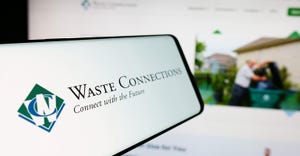Landfill Tipping Fees See Minimal Increases
Despite reports of tipping fees increasing at some landfills across the U.S., industry officials say that these spikes are minimal and in line with inflation and normal rate increases.
“In the central state regions where many of our clients are based we are seeing moderate increases in tipping fees in line with cost of living increases,” says Keith Connor, P.E. project manager for Burns & McDonnell Engineering Co. Inc. based in Kansas City, Miss. “Landfill costs are frequently developed based on cost of service analysis and then frequently checked against prevailing market rates before setting the tipping fees. Some consolidation of landfill ownership is allowing landfills to pass on increased costs rather than absorb them.”
Amanda Pratt, director of communications for Rumpke Waste & Recycling, agrees.
“It's not necessarily a trend we are experiencing at our facilities,” she says. The Cincinnati, Ohio-based company operates nine landfills located in Ohio, Kentucky and Indiana.
“The fees at our landfills consist of different components including taxes, generation fees and host community fees on top of disposal fees,” Pratt says. “Those government mandated components are set by local government and vary depending on the region where the site is located.
Pratt says that Rumpke does not anticipate the fees increasing.
“At the same time, our disposal fees are also not necessarily increasing drastically. Disposal fees are often used for landfill construction and operations to maintain compliance and to ensure that our sites are operated in a manner which maintains Rumpke's status as a good neighbor,” she says.
Rumpke manages changes in fees and operating costs as part of its normal day-to-day business practices.
“The waste industry commands strategic, long-term planning and budgeting,” Pratt says. “Disposal costs for any site we are using or plan to use are carefully considered and budgeted to best position our organization in the marketplace.”
Connor says Burns & McDonnell is seeing increased need for cost of service analysis of solid waste system costs so its clients know their true costs of service, sometimes independent of their decision of where to set tipping fees.
Connor says there are several government regulations and other factors that may increase expenses for landfill operators.
“Landfill gas control needs on many sites have increased as the regulatory community has increased its attention to migration control compliance. These costs as a percentage of overall site costs remain small,” he says. “The recently lowered (New Source Performance Standards) NSPS threshold from 50 to 40 MG of annual (non-methane organic compounds) NMOC emissions will accelerate the need for comprehensive gas systems, a significant new capital and operating expense for some medium sized landfills.”
Landfill tipping fees are typically used to cover operating and maintenance costs. Connor says this can include personnel, equipment, fuel, and anticipated capital costs such and cell expansions, cell closures and capping.
“In addition some non-landfill program costs may be partially or entirely borne by the tipping fee. These costs can include costs for waste minimization, compost programs, food waste, recyclables collection and processing, and waste minimization programs as well as (household hazardous waste) HHW and e-waste programs for some municipalities or authorities,” he says.
Government plays a huge role in determining rates and how the money will be spent. Tipping fees vary widely by location and use of the funds varies as well, according to Pratt.
“Fees determined by local government—host fees—can be used by the local municipality to fund local projects, county fees often fund solid waste management organizations and state fees may help fund state-wide waste reduction programs or other environmental efforts or organizations within the state," she says.
About the Author
You May Also Like


